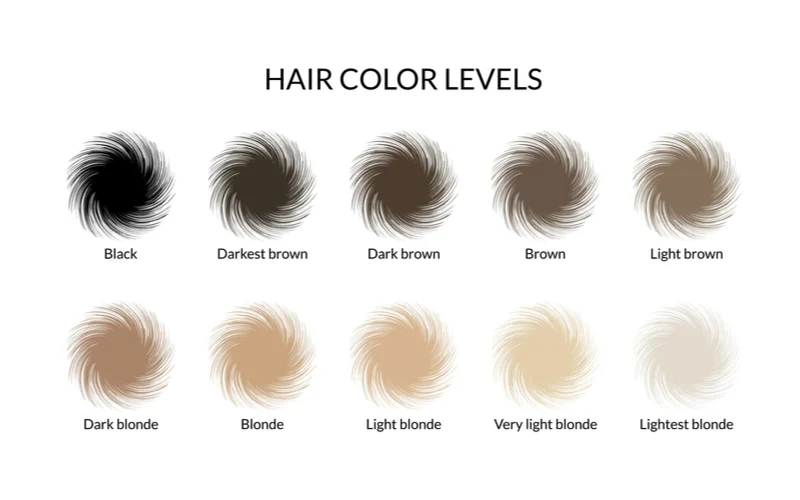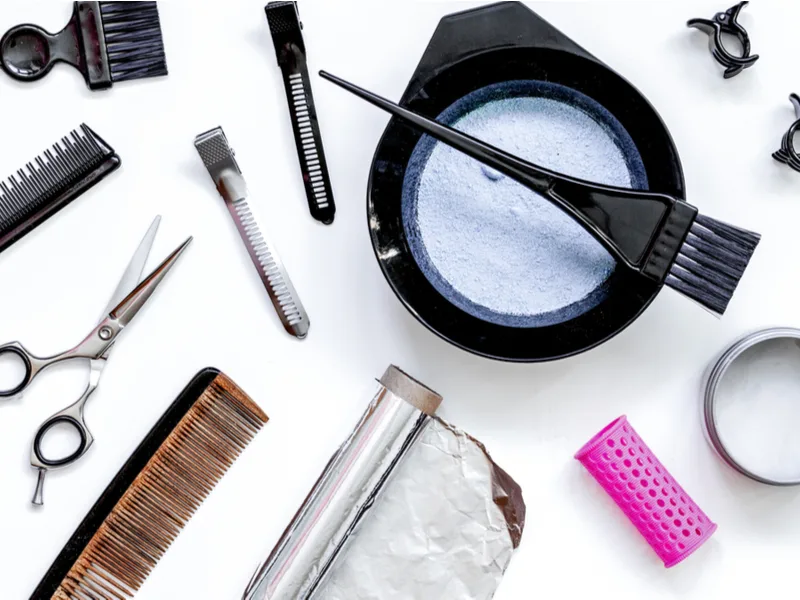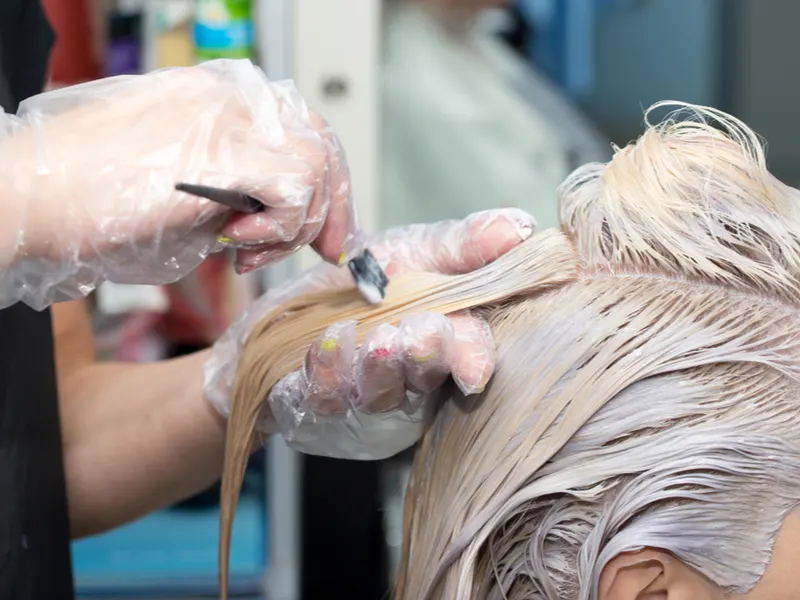Jump to:
As you can tell from the title, the stages of bleaching hair are not something where science and stylists agree. Going from dark to light-colored hair takes time, no matter how many stages it takes. We’ll explain each one in detail below.
What Are the Stages of Hair Bleaching?

Richiksv/Shutterstock
As much as you may want a certain look today, you cannot transform dark-colored hair into blond hair in one session. The process goes in stages with two to four-week breaks in between. Bleaching hair quicker can result in hair that is fried, brittle, dry, and weak.
The important part to get right is to achieve the color you want, and to keep your hair healthy in the process. We’re going to sort out how the stages work later.
The process mixes two chemicals, bleach and volume developer to remove the color from hair. One salon will tell you your hair lightens over a ten-stage process. You go somewhere else, and there aren’t ten stages anymore.
Now hair bleaches in seven stages. It’s all very confusing.
But we’re going to get to the bottom of the hair bleaching rabbit hole and explain everything. Don’t forget to check the Frequently Asked Questions at the bottom if you have questions.
You Might Also Like:
- Does Bleaching Your Hair Damage It Forever?
- How Often Can You Bleach Your Hair?
- How to Lighten Hair Without Using Bleach
The 10 Levels of Hair Bleaching, Explained
The debate over ten or seven stages is quite simple. The seven-stage argument says there are indiscernible tones on each level, and hair bleaches in seven primary colors.
The ten-stage argument does not debate that there are tones in the levels. People who insist there are ten stages feel that seven colors are too simple, and ten colors cover the range better.
The 7-Stage Argument
Remember at the top when we said never go through more than four stages in one sitting? That advice is at the heart of why the seven-stage argument exists. Maybe the system is a salon scam to rake in the dough. Or, maybe this system is the best hair-health advice.
Everybody has a different type of hair and needs to make an individual choice. The idea behind having seven stages is going from black hair to blond hair.
Here are the stages:
1. Medium Brown
Medium brown is the color at the end of the bleaching when starting from black, or a dark brown. In the next stage, dark tones disappear.
2. Light Brown
Light brown is the most common color of hair in two ways: the most common color of natural hair and the most common color to achieve when starting from black.
3. Dark Blond
Dark blond is a “warning” color because people have trouble discerning between light brown and dark blond. Light brown does not contain yellow pigments, while dark blond does. The way hair catches in a certain light will reveal the differences, however slight.
4. Medium Blond
Like dark blond, people who are not good at colors might confuse medium blond with light brown. But, the pigments are a lighter yellow than dark blond.
Only skilled hairstylists should attempt this color. The similarities to the previous two make medium blond an easy color to get wrong.
5. Light Blond
In the industry, we colorists of the world call this stage intense bleaching. Intense — because light blond is the first serious level. Left a little longer, very light tones appear.
A colorist has to have the skill to operate in this range. The bleach can only stay on for a short time. Most clients request a specific color, so timing is everything.
6. Very Light Blond
You should reach this stage after doing a few sessions unless you are a natural blond. Very light blond no longer has bright yellow pigments. The color is a dull, pale yellow.
7. Extra Light Blond, Silver, or White
Virtually no yellow pigment exists anymore. If you want this color and to have healthy hair at the end of the process, let a skilled salon colorist go through the stages properly.
Read Next: How to Get Silver Hair
The 10-Stage Method
The ten-stage style uses a ten pigment depth chart. The chart is the standard found in salons from companies like Wella. You have probably gone to a salon and seen such a chart with hair pigment samples, often with ten stages but possibly twenty colors, or more.
The chart conforms to the International Color Code (ICC) level system. Your current hair color should match one color. If you want to bleach your hair, you should not lift more than four levels of color on the chart in one session.
The result is similar in the beginning to the 7-stage system, except that you can go from black to light brown. To protect hair structure, health, and quality, you would not be back in the salon seat for nearly a month to begin the push toward a light blond.
Bleaching and Toning
When you look at a ten-stage hair chart, which you would use anyway for the seven-stage approach, there are two rows of colors. The reason for the two rows is because of bleaching and toning.
Starting with level one, black hair, count to the right four spaces, and you land on two colors—top row color #5 (four spaces after #1) and bottom row color #5 Light Brown. The top row color represents the bleached color which is full of reds, oranges, and yellows.
The reds are darker, oranges are in the middle, and the yellows are the lightest colors. These colors look unnatural and result purely from bleaching hair. Most people don’t want bleached, untoned hair.
Next, comes the bottom row of colors. The bottom row represents the new color after toning. Toning adds in color on the blue to purple scale. The mix of blue and yellow sounds unnatural at first.
Start with five parts yellow and look at how bright and unrealistic the color looks for hair. Add one part blue and see how much yellow gets toned down, and the pigment starts to take on a natural-looking color suitable for hair.
Toning brings hair back to a natural color with the addition of colors from the blue scale to get away from the unnatural, bright reds, oranges, or yellows bleaching alone creates.
Developers made of hydrogen peroxide come in different volumes to balance with bleach. The breakdown goes, 10-volume lifts 1-2 levels. 20-volume lifts 2-3 levels. 30-volume lifts 3-4 levels. You can go higher than 30-volume, which is an individual decision a skilled colorist should make.
Now that we understand the above, the result in our initial example: #5 is bright with too much unnatural red and orange. After toning, we bring the color down to light brown. Remember, this method assumes we started with black hair.
Read Next: Fixing Gummy Hair After Bleaching
Using the Stages of Hair Bleaching

279photo Studio/Shutterstock
We now understand how to look at the color scale and how to proceed in theory. We have to pretend we have our rubber gloves on, application brushes laid out, and mixing bowls in hand. What’s missing? We need a bleach and volume developer.
As discussed previously, common strengths are 10, 20, and 30-volume developers. 20 is the most common with bleach, where 10 is too weak, and 30 and, especially, 40 are too strong.
When the volume developer is too strong, you can over-process, burn and lose hair. Rely on a pro for help. Some people try to bleach their hair at home, and they can’t get a 20-volume developer to work.
They assume the developer is the problem and consider moving to a 30 or 40-volume developer. Just because hair isn’t doing what you want, does not mean a 40-volume developer is suddenly a good idea. Using a strength of 40 is always a bad idea in combination with bleach.
If you take this problem to a qualified colorist, the first question the colorist should ask is “what kind of bleach are you using?” The previous question does not have to be the first.
If the colorist never asks, you’re talking to the wrong person. Look elsewhere. There are a lot of bleaches on the market, too many to discuss here. Before taking on the challenge at home, research the products you can purchase.
Prepare the Hair
I do not recommend washing your hair before bleaching. Your hair has natural oils that a wash depletes. These oils are there because they protect your hair, including from bleach. Apply the bleach to dry hair.
If you have not washed your hair for a few days, even better. Before dividing the hair into sections, thoroughly brush out all tangles until smooth and open. You only need to divide a whole head of hair into four equal sections.
Tie or clip three sections up and let one hang down. The down section gets the first treatment. Foil locks in heat and causes the bleach to work faster.
After you see the hair has lifted, you can remove the foil and get ready to rinse. Bear in mind, that the above explains preparing and what will happen in theory. What you will do in practice comes in the next step.
Blend Bleach and Developer
So far, I have skirted around what bleach and developer are. In the coloring industry, we only say bleach when we are going to lift the tone of the hair. The mixture that does the bleaching contains bleach and volume developer.
The volume developer is hydrogen peroxide. You are likely to use a 20-volume developer to lift hair 2-to 3 levels.
The rule of thumb, mix 1 part of bleach with 2 parts of a developer. Mixing should create a thick creamy or gravy-like consistency in your bowl. The mixture should cling to your brush and spread well.
Read Next: Which Developer Should You Use?
When to Rinse
I intentionally glossed over applying the mixture because the procedure is straightforward. Plus, people may request abstract styles that change a one-size-fits-all explanation. If you are applying the bleach to the whole head, do the roots, body, and ends equally.
Knowing when to rinse is straightforward. You should rinse within 15-30 minutes, depending on how much color needs to lift. Check under the foil occasionally until the color looks right. What is “right?” “Right” is whatever the initial color should be before toning to get a natural color.
Most people want different colors. Rinse with an acidic hair product to close the cuticles and return hair to its natural acidity. Remember, we just soaked the hair in bleach, a base. Re-balance the pH of your hair with something acidic.
Tone the Hair
The time has finally arrived to do toning, all that blue and purple we went over previously. There are many toning options. Suffice to say, after bleaching, hair can look almost ghostly white or whitish-yellow.
Toning adds in some range of blues and purples to give the hair body and depth and look more like a color balance found in nature, yet achieved unnaturally.
Frequently Asked Questions

Schankz/Shutterstock
What are the stages of bleaching hair?
First, you add bleach which can potentially turn black hair white. Then you do toning to add darker blues and purple hues to achieve a more natural blond. The stages exist because you should divide the process into sessions to keep hair healthier.
How long does bleaching hair usually take?
The bleaching itself only takes 15-20 minutes on average. After that, further toning adds some extra time.
How many levels does bleach lift?
Bleach can lift as many levels as you want if you don’t rinse the hair. All qualified colorists recommend lifting a few levels at a time and toning to avoid damaging the hair and scalp.
How many bleaches does it take to go from dark brown to blonde?
Virgin hair might be able to go in one session. Previously treated hair has to go through a more deliberate process to avoid damage, possibly two to three sessions.
How many levels can you lift hair in one session?
Qualified colorists recommend doing no more than four levels per session. Rely on experienced advice to maintain hair health and prepare to go through multiple sessions if necessary.
So, What Are the Stages of Bleaching Hair?
In theory, the stages are roughly black to light brown to blond to very light blond. Toning along the way achieves a more natural color.
In practice, trust your hair professional. After inspecting your hair, a pro might recommend you do more sessions at a slower pace to avoid doing unnecessary damage.
